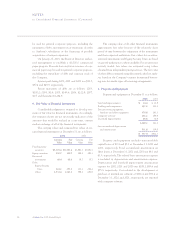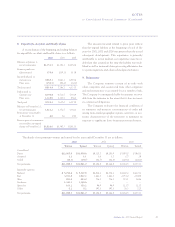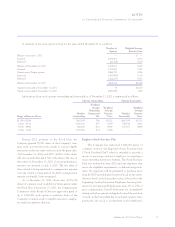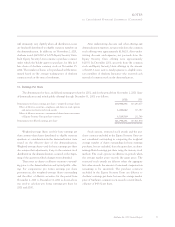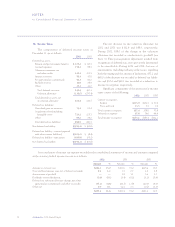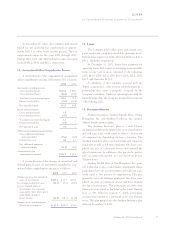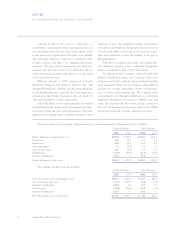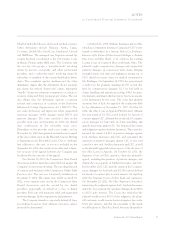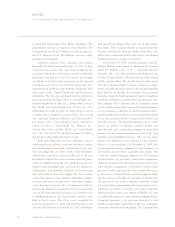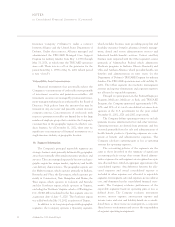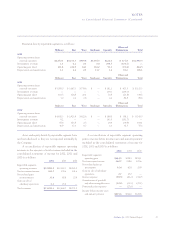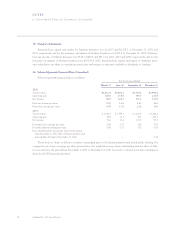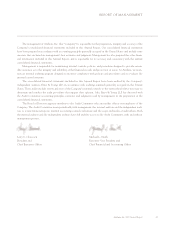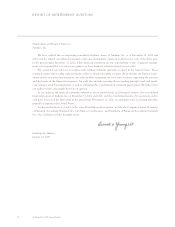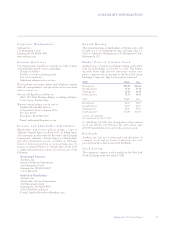Anthem Blue Cross 2002 Annual Report Download - page 83
Download and view the complete annual report
Please find page 83 of the 2002 Anthem Blue Cross annual report below. You can navigate through the pages in the report by either clicking on the pages listed below, or by using the keyword search tool below to find specific information within the annual report.
NOTES
to Consolidated Financial Statements (Continued)
78 Anthem, Inc. 2002 Annual Report
16. Long Term Incentive Plan
Certain executives are participants in a Long Term
Incentive Plan (“LTIP”). The LTIP operates during suc-
cessive three-year periods. At the beginning of each
three-year period, the Compensation Committee estab-
lishes performance goals, which include specific strategic
objectives such as growth in net income, operating mar-
gin and comparison of performance against peer compa-
nies. Each participant’s target award is established as a
percentage ranging from 30% to 150% of annual base
salary for each year of the three-year period. The award
can be paid in cash or stock of the Company. The LTIP
expense for 2002, 2001 and 2000 totaled $75.6, $49.9 and
$50.9, respectively.
17. Contingencies
Litigation
A number of managed care organizations have been
sued in class action lawsuits asserting various causes of
action under federal and state law. These lawsuits typi-
cally allege that the defendant managed care organiza-
tions employ policies and procedures for providing health
care benefits that are inconsistent with the terms of the
coverage documents and other information provided to
their members, and because of these misrepresentations
and practices, a class of members has been injured in that
they received benefits of lesser value than the benefits
represented to and paid for by such members. Two such
proceedings, which allege various violations of the
Employee Retirement Income Security Act of 1974
(“ERISA”), have been filed in Connecticut against the
Company or its Connecticut subsidiary. One proceeding
was brought by the Connecticut Attorney General on
behalf of a purported class of HMO and Point of Service
members in Connecticut. No monetary damages are
sought, although the suit does seek injunctive relief from
the court to preclude the Company from allegedly utiliz-
ing arbitrary coverage guidelines, making late payments
to providers or members, denying coverage for medically
necessary prescription drugs and misrepresenting or fail-
ing to disclose essential information to enrollees. The
complaint contends that these alleged policies and prac-
tices are a violation of ERISA. A second proceeding,
brought on behalf of a purported class of HMO and Point
of Service members in Connecticut and elsewhere, seeks
injunctive relief to preclude the Company from allegedly
making coverage decisions relating to medical necessity
without complying with the express terms of the policy
documents, and unspecified monetary damages (both
compensatory and punitive).
In addition, the Company’s Connecticut subsidiary
is a defendant in three class action lawsuits brought on
behalf of professional providers in Connecticut. The suits
allege that the Connecticut subsidiary has breached its
contracts by, among other things, failing to pay for serv-
ices in accordance with the terms of the contracts. The
suits also allege violations of the Connecticut Unfair
Trade Practices Act, breach of the implied duty of good
faith and fair dealing, negligent misrepresentation and
unjust enrichment. Two of the suits seek injunctive relief
and monetary damages (both compensatory and puni-
tive). The third suit, brought by the Connecticut State
Medical Society, seeks injunctive relief only. On July 19,
2001, one of the suits was certified as a class suit as to
three of the plaintiff’s fifteen allegations. The class is
defined as those physicians who practice in Connecticut
or group practices which are located in Connecticut that
were parties to either a Participating Physician Agreement
or a Participating Physicians Group Agreement with the
Company and/or its Connecticut subsidiary during the
period from 1993 to the present, excluding risk-sharing
arrangements and certain other contracts. The claims
which were certified as class claims are: the Company’s
alleged failure to provide plaintiffs and other similarly sit-
uated physicians with consistent medical utilization/qual-
ity management and administration of covered services
by paying financial incentive and performance bonuses to
providers and the Company’s staff members involved in
making utilization management decisions; an alleged fail-
ure to maintain accurate books and records whereby
improper payments to the plaintiffs were made based on
claim codes submitted; and an alleged failure to provide
senior personnel to work with plaintiffs and other simi-
larly situated physicians. The Company has appealed the
class certification decision.
On September 26, 2002, Anthem, Inc. was added as
a defendant to a Multi District Litigation (“MDL”) class
action lawsuit pending in Miami, Florida brought on


